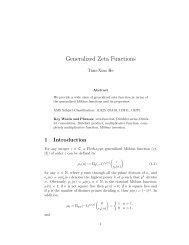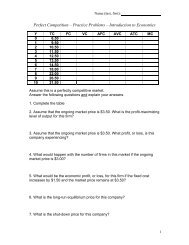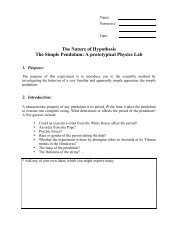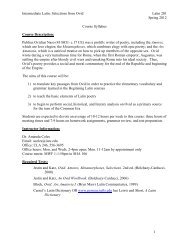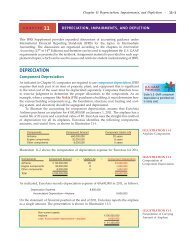THE OPEN AGGREGATE DEMAND – AGGREGATE SUPPLY ...
THE OPEN AGGREGATE DEMAND – AGGREGATE SUPPLY ...
THE OPEN AGGREGATE DEMAND – AGGREGATE SUPPLY ...
Create successful ePaper yourself
Turn your PDF publications into a flip-book with our unique Google optimized e-Paper software.
<strong>THE</strong> <strong>OPEN</strong> <strong>AGGREGATE</strong> <strong>DEMAND</strong> <strong>–</strong> <strong>AGGREGATE</strong> <strong>SUPPLY</strong> MODEL.<br />
Introduction.<br />
This model represents the workings of the economy as the interaction between two curves:<br />
- The AD curve, showing the relationship between the price level (P) and aggregate demand<br />
(AD), that is, real output (Y)<br />
- The AS curve, showing the relationship between the price level (P) and aggregate supply<br />
(AS), that is, real output (Y)<br />
The Aggregate Supply and Aggregate Demand Model in an Open Economy.<br />
The Aggregate Demand Curve<br />
Recall that through the expenditure approach to GDP calculation we can figure out which<br />
were the uses given to all the goods and services produced during a year (that is, who<br />
demanded them). In an open economy:<br />
Y = GDP = C + I + G + NX = AD<br />
where:<br />
C = Consumption (expenditure by domestic households)<br />
I = Investment (expenditure by firms), can be domestic or foreign.<br />
G = Government Expenditure (you take a guess ;-)<br />
NX = Net Exports (expenditure by the rest of the world) = X - M<br />
AD = Aggregate Demand = Y = Real Output (recall circular flow diagram)<br />
All the components of Aggregate Demand (except G) are inversely related to the price level:<br />
- ↑P reduces Consumption (↓C)<br />
- ↑P reduces Investment (↓I) because the nominal interest rate rises (↑i) (recall that i = r + π)<br />
- ↑P reduces Net Exports (↓NX) because the price of X increase relative to the price of M<br />
- Government Expenditure (G) does not depend on the price level<br />
Therefore the Aggregate Demand curve is going to be a downward sloping line.<br />
(See Aggregate Demand curve)<br />
<br />
How different is this open-economy AD curve from the (mostly closed-economy) one that you<br />
saw in Principles or maybe in Intermediate Macro They are almost identical:<br />
1
− In an open economy the AD curve is somehow flatter because a higher (lower) domestic price<br />
level (P) will have a larger repercussion on AD through lower (higher) X and K IN (foreign I)<br />
− In an economy with flexible ERs the AD curve will be flatter than in an economy with fixed<br />
ERs because a higher (lower) domestic price level (P) increases (decreases) demand for<br />
imports ↑M (↓M) and that in turn raises (lowers) demand for foreign currency and so ERs. In<br />
this case there is an even larger repercussion on AD through the Current Account (CA.)<br />
Movements along the AD curve:<br />
- We move up along the AD curve only if the price level increases: ↑P → ↓Q of AD.<br />
- We move down along the AD curve only if the price level decreases: ↓P → ↑Q of AD.<br />
Shifts in the AD curve:<br />
- The AD curve shifts right if: • Any of the AD components increases: ↑C, ↑I, ↑G, ↑X, ↓M.<br />
• Expansionary fiscal policy is applied: ↓T, ↑G.<br />
• Expansionary monetary policy is applied: ↑M → ↓i → ↑I<br />
• The domestic currency depreciates: ↑ER→ ↓M → ↑X<br />
- The AD curve shifts left if: • Any of the AD components decreases: ↓C, ↓I, ↓G, ↓X, ↑M.<br />
• Contractionary fiscal policy is applied: ↑T, ↓G.<br />
• Contractionary monetary policy is applied: ↓M → ↑i → ↓I<br />
• The domestic currency appreciates: ↓ER→ ↓X → ↑M<br />
The AD curve is basically affected by monetary and fiscal policies (↑↓ in M, T, G) that<br />
are also known as demand policies (as opposed to supply policies.)<br />
- Expansionary monetary or fiscal policies shift the AD line right<br />
- Contractionary monetary or fiscal policies shift the AD line left<br />
The AD curve is also affected by expenditure switching and direct control policies (↑↓ in<br />
Tariffs, Quotas, ERs, Capital Controls), directed towards the Balance of Payments.<br />
2
The Aggregate Supply Curve<br />
<br />
We will distinguish between:<br />
- The Long-Run Aggregate Supply curve LRAS, that represents the relation between the price<br />
level (P) and the level of output (Y) produced by firms in the long-run.<br />
Recall the concept of the production function from Principles or Intermediate Macro:<br />
LRAS = Y = A . F (K, N)<br />
Since the levels of physical capital (K), or labor (N), available in the long-run to any given<br />
country do not depend on the price level we can represent the LRAS as a vertical line.<br />
(See Long-Run Aggregate Supply line)<br />
Shifts in the LRAS curve:<br />
- The LRAS curve shifts right if: • Any of the factors of production increase: ↑K, ↑N.<br />
• There is a technological improvement: ↑A.<br />
- The LRAS curve shifts left if: • Any of the factors of production decrease: ↓K, ↓N.<br />
• There is a reduction in technology: ↓A.<br />
- The Short-Run Aggregate Supply curve SRAS, that represents the relation between the price<br />
level (P) and the level of output (Y) produced by firms in the short-run.<br />
Private firms increase their output level as the selling price of their goods increase (P) but they<br />
also take into consideration the production costs (P of inputs).<br />
SRAS = Y = A . F (K, N) / P of inputs<br />
We can then represent the SRAS as an upward sloping line.<br />
Some authors, in order to simplify their analysis, may consider the aggregate level of output<br />
supplied in the short-run to be completely elastic with respect to the price level. In that case the<br />
SRAS will be represented with a horizontal line. The conclusions would be identical.<br />
(See Short-Run Aggregate Supply line)<br />
Movements along the SRAS curve:<br />
- We move up along the SRAS curve only if the price level increases: ↑P → ↑Q of SRAS.<br />
- We move down along the SRAS curve only if the price level decreases: ↓P → ↓Q of SRAS.<br />
3
Shifts in the SRAS curve:<br />
- The SRAS curve shifts right if: • Any of the factors of production increase: ↑K, ↑N.<br />
• There is a technological improvement: ↑A.<br />
• There is a decrease in production costs: ↓P of inputs.<br />
- The SRAS curve shifts left if: • Any of the factors of production decrease: ↓K, ↓N.<br />
• There is a reduction in technology: ↓A.<br />
• There is an increase in production costs: ↑P of inputs.<br />
<br />
Notice that fiscal nor monetary policies affect the supply side of the economy. Only long-run<br />
government policies (e.g: universal education, support of scientific enterprises) have an impact<br />
on aggregate supply.<br />
How different is an open-economy SRAS curve from the (mostly closed-economy) one that<br />
you saw in Principles or maybe in Intermediate Macro This is a very good question.<br />
− The study of the impact that free trade and free capital mobility has on the supply side of the<br />
economy is a fertile field of research in economics. What do we know so far<br />
− Increased international competition by foreign firms forces most domestic firms to increase<br />
their productivity, reduce their price markups, and expand their scale of operations (allowing<br />
for increased returns to scale.) Some firms will have to shut-down, though.<br />
− Unfortunately, most of this analysis falls outside the material generally covered in<br />
undergraduate macroeconomics courses and will not be discussed in class.<br />
− Translated into the AS-AD model these conclusions can be represented with a somehow flatter<br />
SRAS curve, or even a LRAS curve that is further to the right of a closed economy situation.<br />
Equilibrium<br />
At any given moment in time the level of economic activity is going to be determined by the<br />
intersection of the aggregate demand and the aggregate supply curves.<br />
The different phases of the business cycle can be described in terms of the AS-AD model<br />
− When the SRAS and AD curves intercept to the left of the LRAS curve the short-run level of<br />
output is below the full-employment level of output (Y*>Y E ), creating what is known as a<br />
recessionary gap (u E > u*).<br />
4
− When the SRAS and AD curves intercept to the right of the LRAS curve the short-run level of<br />
output is above the full-employment level of output (Y E > Y*), creating what is known as an<br />
inflationary gap (u*>u E ).<br />
− When the SRAS and AD curves intercept over the LRAS curve the short-run level of output is<br />
the same as the full-employment level of output (Y*=Y E ), a situation known as a long-run<br />
equilibrium (u*=u E ).<br />
Keep in mind that neither fiscal nor monetary policies can promote long-run economic<br />
growth. Both of them are short-run demand-side policies, that don’t have an immediate, direct<br />
impact on the determinants of potential (full employment) GDP (i.e.: K, L, and A.)<br />
− An excessive growth of AD will create rapid growth (Y E >Y*) but as the general price level<br />
rises, the cost of inputs increase and so the SRAS curve shifts left (so Y*=Y E , with P E > P*).<br />
− A depressed AD will create large unemployment (Y*>Y E ) but as the general price level falls,<br />
the cost of inputs decrease and so the SRAS curve shifts right (so Y*=Y E , with P E < P*).<br />
<br />
We can now use this model to analyze how the tools of macroeconomic policy can be used to<br />
achieve internal and external balance in a variety of scenarios.<br />
Internal Macroeconomic Analysis with the AS-AD Model<br />
The crossing of the AD and SRAS curves (Y E ) will represent the short-run equilibrium in<br />
the economy, defining the equilibrium price level (π E )<br />
Whether or not that short-run equilibrium represents the full employment (Y*) of all factors<br />
of production (K and N) can be seen on the graph:<br />
− When Y E < Y*, and therefore, u E > u*, there is a recessionary gap.<br />
− When Y E > Y*, and therefore, u E < u*, there is an expansion, and an inflationary gap.<br />
Two different types of economic policies can be applied to close a recessionary gap:<br />
- Expansionary fiscal policy: ↓T or ↑G (at the new equilibrium ↑Y but also ↑P)<br />
• ↑G or ↓T may cause some crowding out of private investment<br />
- Expansionary monetary policy: ↑M (at the new equilibrium ↑Y but also ↑P)<br />
• ↑M may be ineffective if there is a liquidity trap or inflationary expectations by households.<br />
Regardless of the economic policy employed, the general price level will be likely to rise.<br />
5



